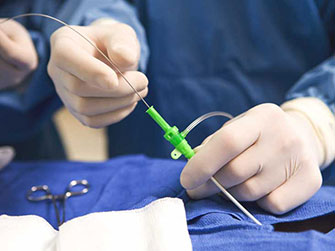
Cardiac catheterization is an invasive procedure performed to identify problems in the heart. During the procedure, using a long thin tube called a catheter, your cardiologist can:
- Identify blockages or narrowing of the blood vessels
- Determine the amount of oxygen in the heart
- Identify problems affecting the valves of the heart
- Identify congenital heart defects
- Take a biopsy (tissue) from the heart
- Test the pressure inside the heart
Some heart disease treatments, such as an angioplasty, are also performed using cardiac catheterization. During an angioplasty, a tiny balloon is inserted temporarily to help widen a narrow artery.
How do I prepare for the procedure?
To ensure optimal results, do not eat or drink anything eight to 12 hours before the test. Remember to bring all your medications, including supplements with you on the day of your procedure. Lastly, although it’s quite normal for you to feel nervous or anxious about the procedure, try to relax. Nervousness may cause your heart to beat rapidly and irregularly, causing test results to be inaccurate.
What happens during the procedure?
Cardiac catheterization is performed in a special operating room within a hospital, known as the catheterization lab. This lab contains X-ray and imaging machines that normal operating rooms do not have.
You’ll be awake during the test, but sedated, so you’ll be able to follow instructions. The nurse will insert an IV in your arm or hand in case you need additional medications during the procedure. Your heartbeat will also be monitored.
Prior to inserting the catheter in your artery, you’ll receive a shot of anesthetic to numb the area. The catheter may be inserted in an artery or vein in your neck, arm, or groin. The catheter will be threaded through the blood vessels to the heart. You should not feel any pain or feel the catheter moving through your body. If you experience any discomfort, inform your cardiologist.
What happens after the procedure?
Typically, it takes several hours to recover. Following the procedure, you’ll be taken to a recovery room, where you’ll remain until the anesthesia wears off, which usually happens within an hour. After recovery, you’ll be placed in a hospital room.
Do not move the limb that your catheter was inserted in to, as this could cause serious bleeding. Once the nurse removes the catheter, he or she will apply pressure to the insertion site. You’ll have to lie flat for one to six hours to prevent severe bleeding and to enable the artery to heal.
You will be given food or drink after the test. You may be able to go home the same day or you may have to stay a little longer, depending on your condition, and the extent of your procedure.
Results
The results of a cardiac catheterization may indicate that surgery or another treatment is necessary. Your cardiologist will thoroughly discuss the results and treatment options with you.
Risks
As with any procedure performed on the heart and blood vessels, there are some risks. Risks include:
- Bleeding
- Heart attack
- Bruising
- Stroke
- Infection
- Blood clots
- Kidney damage
- Irregular heart rhythm
- Damage to the artery where the catheter was inserted
Major complications as a result of a cardiac catheterization rarely occur. Remember, your cardiologist has recommended this procedure because the benefits of treating your heart condition far outweigh the risks.